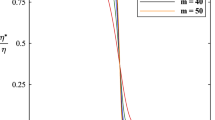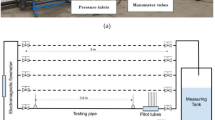Abstract
GADD1 has summarized some of the recent work in friction reduction by high molecular weight additives and concludes that the primary mechanism is a thickening of the laminar sublayer. Investigations of the effect of such additives on pipe flow carried out at West Virginia University support this explanation.
Similar content being viewed by others
References
Gadd, G. E., Nature, 212, 875 (1966).
Castro, W., thesis, West Virginia Univ. (1966).
Ripken, J. E., and Pilch, M., Univ. Minnesota Project No. 71 (1964).
Costrell, J., thesis, West Virginia Univ. (1966).
Squire, W., App. Sci. Res., A, 10, 23 (1961).
Davies, G. A., and Ponter, A. B., Nature, 212, 66 (1966).
Deryaguin, B. V., Pure App. Chem., 10, 375 (1965).
Author information
Authors and Affiliations
Rights and permissions
About this article
Cite this article
SQUIRE, W., CASTRO, W. & COSTRELL, J. Mechanism of Turbulent Friction Reduction in Pipes by Dissolved Additives. Nature 213, 1008–1009 (1967). https://doi.org/10.1038/2131008a0
Received:
Issue Date:
DOI: https://doi.org/10.1038/2131008a0
- Springer Nature Limited
This article is cited by
-
Power laws of reduced turbulent friction for polymer solutions
Journal of Engineering Physics (1975)
-
On similarity laws for the developed turbulence of dilute polymer solutions
Journal of Engineering Physics (1973)





